How to Grow and Plant Daffodils
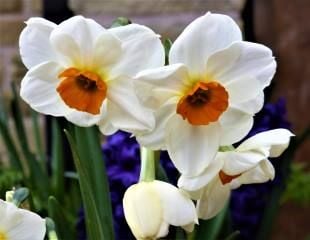
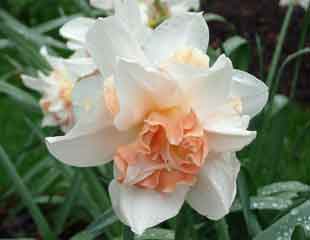
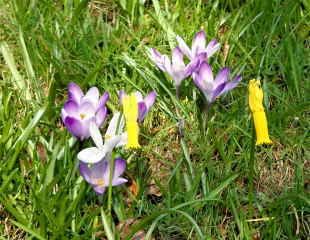
We may think of Daffodils as large yellow trumpets of colour, but there are so many more daffodils to choose from. There are now around 13,000+ varieties in existence. Above are three quite different daffodils, the N. cyclamineus is even smaller than tete a tete.
Some of the most rewarding Daffodils are the scented varieties such as Narcissus 'Bridal Crown', Narcissus 'Geranium' and a long-standing popular variety Narcissus 'Cheerfulness. This combines the lovely bright flowers with scent, ideal as a cut flower. More suggestions for scented narcissus below.
Once you have selected your daffodils, the most important thing is to plant them in the correct depth.
How to Plant Narcissus common name Daffodil
A common question is why don't spring bulbs flower? There can be several reasons, but the most common reason is that the bulbs have been planted too shallow.
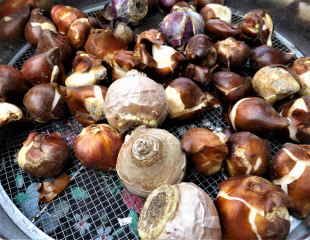
Bulbs come in all sizes, from tiny snowdrop bulbs to the large Alliums.
Planting too shallow can cause bulbs, particularly Daffodils, to come up" blind" which means without flowers. A good rule of thumb when planting bulbs is always to plant them at least 3x the depth of the bulb.
It is clear from this and the various sizes of bulbs, that Hyacinths will need to be planted deeper than Daffodil bulbs, and the smaller Daffodils bulbs, such as Tete at Tete, not so deep. If you are planting a few, it is handy to measure on a bamboo cane the 3x depth, and then each time you dig a hole, put the cane in to check the depth and then plant.
When choosing where to plant daffodils, it is worth bearing in mind they are vulnerable to poor weather. Snow, heavy rain and gusty winds can cause daffodils to fall over. Sadly, after all the effort you put into planting daffodils, they bloom and then get flattened by the weather. There are some steps you can take to prevent, see below.
If you are planting in containers, layer the bulbs with the larges at the bottom, Hyacinth, tulips, daffodils, smaller daffodils, crocus, and snowdrops. This will naturally ensure that the larger bulbs enjoy the greater depth of soil. Also, for the first year planting it is not necessary to use fresh compost. New bulbs are a complete unit with their own food source and will grow in old compost. You can use old compost for the first year of planting more information about this.
Types of Daffodils
Daffodils are grouped into 13 main divisions based on flower shape, size, and bloom habit, for example:
Trumpet – Large trumpet-shaped corona, single flower per stem.
Large-Cupped – Cup is more than one-third the length of petals.
Small-Cupped – Cup less than one-third of petal length.
Double – Flowers have extra petals or multiple coronas.
Triandrus – Nodding, bell-shaped flowers on multiple stems.
Cyclamineus – Reflexed petals, slender stems.
Jonquilla – Fragrant, multi-flowered stems.
Tazetta – Strongly scented, multiple flowers per stem.
Poeticus – Small, white petals with distinct corona and orange/red eye.
10–13. Various hybrid and miscellaneous types.
Scented daffodils
I just love scented daffodils. They look great in the border and make excellent cut flowers. The multi headed varieties provide many flowers and scent from just the one bulb.
Some excellent scented daffodils varieties are:'
Grand Monarque' tall, early flowering, strong scent;
Thalia is pure white and scented;
Cheerfulness very fragrant with up to 6 blooms per stem;
Abba ( has the AGM) double white with orange, three to five blooms per stem with spicy scent;
also with AGM is Avalanche white with yellow cup good scent;
Rose of May double white scented blooms;
Erlicheer pale flowers with a strong scent said to small of vanilla;
Marguerite Patten, named after the cook, has good scent and again multiple blooms per stem;
and Topolino is a traditional-looking daffodil with white petals, and yellow cup also scented.
Suttons have an excellent selection of scented daffodils, including collections containing varieties of daffodil bulbs all of which scented.
Where to see daffodil displays
Daffodils are really dramatic when planted on masse and there are lots of country gardens to visit to see a great daffodil display. Best time to visit (if our weather is behaving itself ) is Mid march onwards and some suggestions, Anglesey Abbery in Cambridgeshire, Arley Hall in Cheshire, Brodie Castle in Scotland.
Also check out Great British Daffodil Gardens
National Garden Scheme Best Daffodil Gardens
and Country Living which has a good selection of daffodil gardens.
Why do daffodils fall over?

There are several reasons that daffodils fall over, especially after flowering.
Varieties with large flower heads are more susceptible to bad weather such as snow, heavy rain and gusty winds. The flower heads become even heavier with the rain and then get blown about.
If you are planting daffodils in an exposed area, plant Daffodils with shorter stem because they better withstand adverse weather. Check out 10 award winning AGM daffodils with short stems recommended by the RHS. Plant those with larger blooms in sheltered positions, such as tucked in under-planting shrubs. Also, plant these varieties deeper, so they anchor into the soil. If all else fails, try a plant support. If your daffodils fall over, you can try digging them up and replanting deeper.
What to do with daffodils after flowering
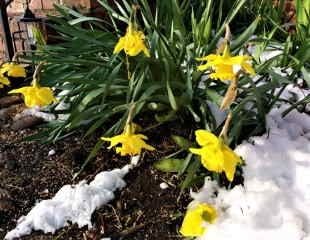
How you treat Daffodils after flowering is important for next year's flowers.
It is safe to dead head Daffodils, taking the top, just removing the spent flower and no more. It is important not to tie up or restrict the fading leaves, which will increase the risk of the Daffodils coming up blind next year. The leaves help to provide food to the bulb for next year.
If you are growing Daffodils in a lawn, avoid mowing for about 6 weeks. This is also the time to feed Daffodils, a balanced liquid feed every couple of weeks until the foliage has died down.
An Inspring Spring Combination
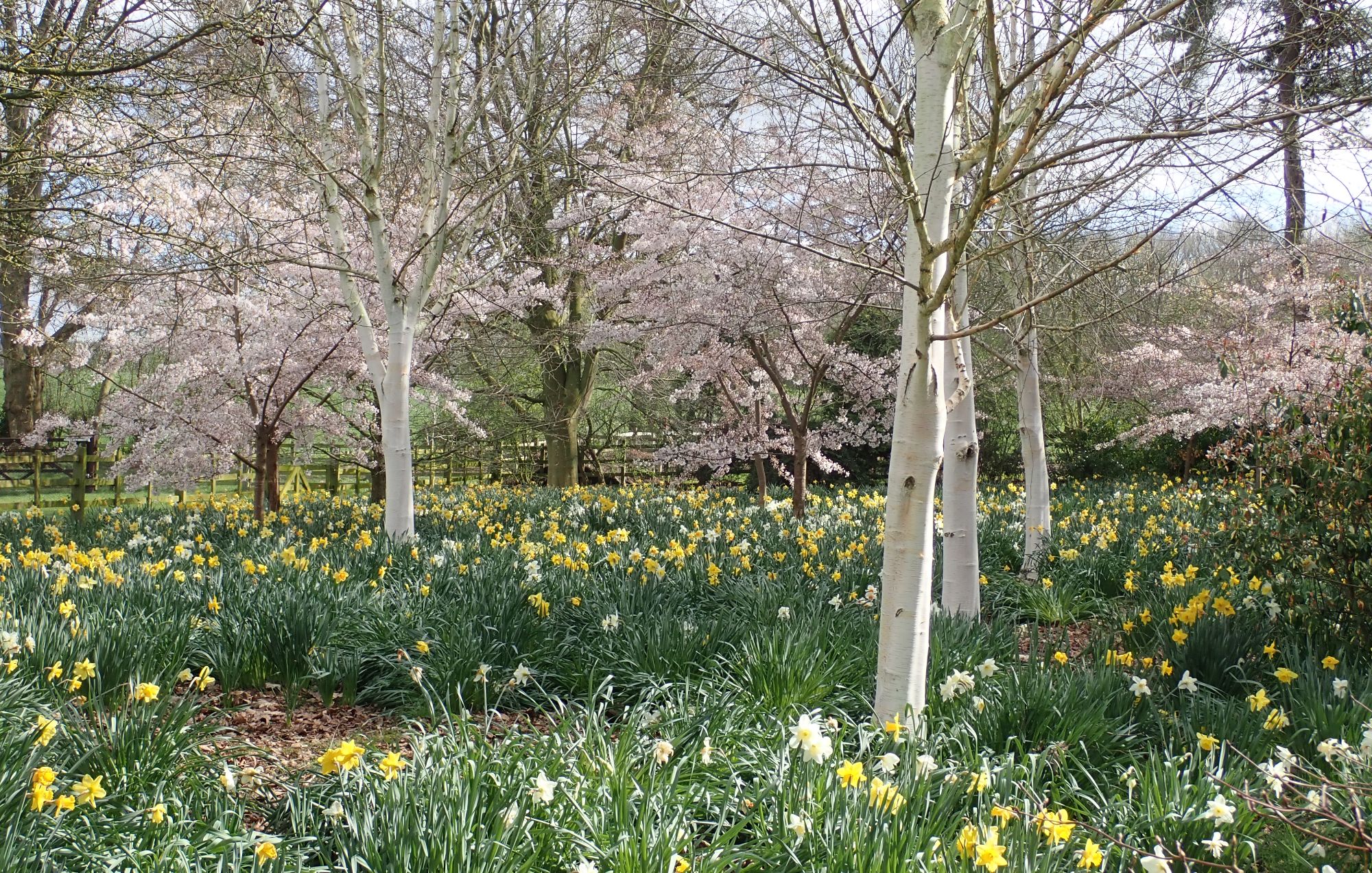
This combination is the Himalayan white birch,Betula Utilis Jacquemontii, with spring blossom and underplanted with daffodils. It makes a beautiful display in a spring garden and I took this image at an open NGS garden, Stoke Albany House.
And now for something completely different, Sea Daffodils.
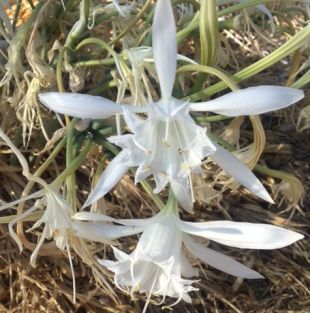
Often spotted growing in the dunes on beaches around the Mediterranean, Pancratium maritimum, the sea daffodil has lovely white flowers on a short stem. In its native habitat, it flowers from August to October and is not related to the daffodil, although it is a bulb. In theory it is possible to grow in the UK, it is hardy down to -5, but the sea daffodil does need a hot summer to induce flowering, markedly absent this year,(and others,) 2023. If there is not enough sun, the flowers might not bloom well.
You are bound to find it on a beach if you holiday around the Med, along with Sea Holly and other natives.
Our native Daffodil Narcissus pseudonarcissus
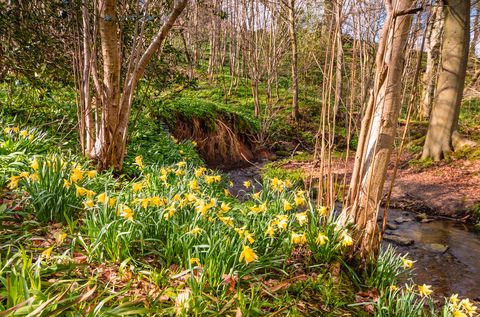
We do have a native Daffodil, Narcissus pseudonarcissus, which at one time grew freely in woodland but is now much less common. It is smaller, with pale leaves and a darker yellow trumpet. You can still find it growing in areas of South Devon, the Black Mountains in Wales, the Lake District in Cumbria, and along the Gloucestershire-Herefordshire borders. This image is of Daffodils in a woodland setting, possibly wild Daffodils growing in Letah Wood a rural, ancient woodland through which Letah Burn runs, near Hexham in Northumberland.
I label daffodils as green wheelbarrow because they are easy to grow.

